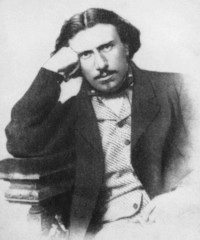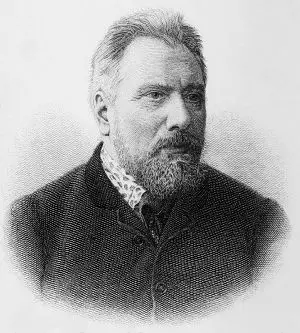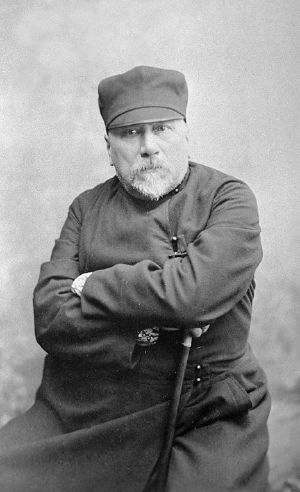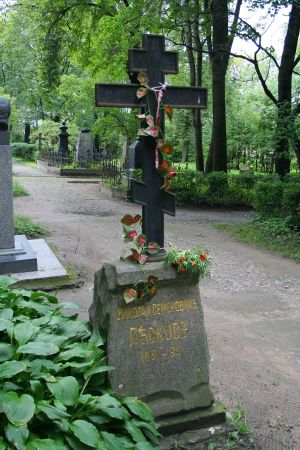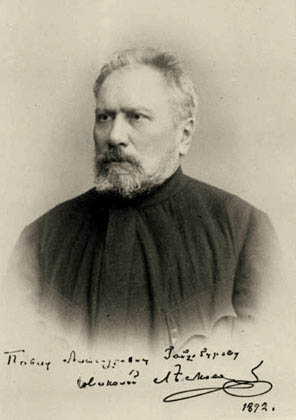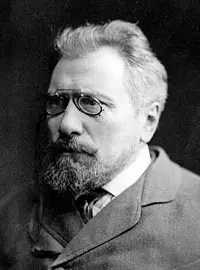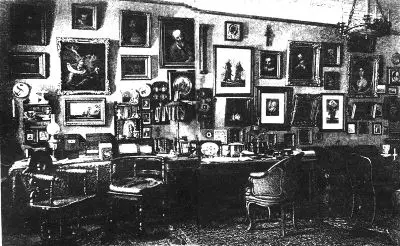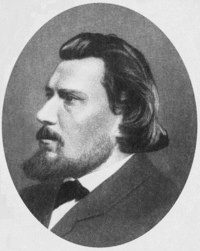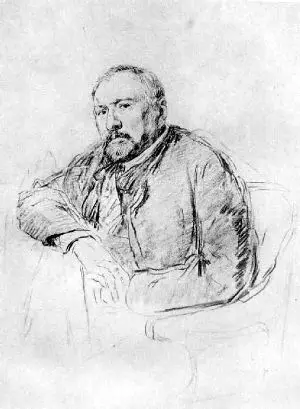Nikolai Leskov
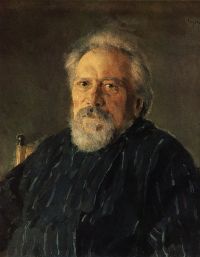 Portrait of Leskov by Valentin Serov, 1894 | |
| Pseudonym(s): | M. Stebnitsky |
|---|---|
| Born: | 16 February 1831 Gorokhovo, Oryol Gubernia, Russian Empire |
| Died: | 5 March 1895 (aged 64) St. Petersburg, Russian Empire |
| Occupation(s): | Writer |
| Nationality: | Russian |
| Writing period: | 1860s–1890s |
| Literary genre: | Fiction/Satirical Fiction |
| Subject(s): | Social issues |
Nikolai Semyonovich Leskov (Russian: Никола́й Семёнович Леско́в; 16 February [O.S. 4 February] 1831 – 5 March [O.S. 21 February] 1895) was a Russian novelist, short-story writer, playwright, and journalist, who also wrote under the pseudonym M. Stebnitsky. Praised for his unique writing style and innovative experiments in form, and held in high esteem by Leo Tolstoy, Anton Chekhov, and Maxim Gorky among others, Leskov is credited with creating a comprehensive picture of contemporary Russian society using mostly short literary forms.
His literary career began in the early 1860s with the publication of his short story The Extinguished Flame (1862), and his novellas Musk-Ox (May 1863) and The Life of a Peasant Woman (September, 1863). His first novel No Way Out was published under the pseudonym M. Stebnitsky in 1864. From the mid-1860s to the mid-1880s Leskov published a wide range of works, including journalism, sketches, short stories, and novels. Leskov's major works, many of which continue to be published in modern versions, were written during this time. A number of his later works were banned because of their satirical treatment of the Russian Orthodox Church and its functionaries.
Biography
Early life
Nikolai Semyonovich Leskov was born on February 4, 1831, in Gorokhovo, Oryol Gubernia, to Semyon Dmitrievich Leskov (1789–1848), a respected criminal investigator and local court official, and Maria Petrovna Leskova (née Alferyeva; 1813–1886),[1] the daughter of an impoverished Moscow nobleman, who first met her future husband at a very young age when he worked as a tutor in their house. Leskov's ancestors on his father's side were all clergymen in the village of Leska in Oryol Gubernia, hence the name Leskov. Semyon Dmitrievich was a well-educated man; friends referred to him as a "homegrown intellectual."[2] One of Nikolai's aunts on his mother's side was married to a rich Oryol landlord named Strakhov who owned the village of Gorokhovo ("a beautiful, wealthy and well-groomed estate... where the hosts lived in luxury," according to Leskov)[3] another was the wife of an Englishman, the chief steward for several local estates and a large trade company owner.[4] Leskov spent his first eight years in Gorokhovo, where his grandmother lived and where his mother was only an occasional guest. He acquired his early education in the house of Strakhov, who employed tutors from Germany and France for his own children.[5] As the German teacher started to praise Leskov for his gifts, his life became difficult as his hosts became jealous. At his grandmother's request, his father took Nikolai back to Oryol where he settled in the family house at 3 Dvoryanskaya Street.[1]
In 1839 Semyon Leskov lost his job. He got into a row and provoked the wrath of the governor himself. "So we left our house in Oryol, sold what we had in the city and bought a village with 50 peasants in the Kromy region from general A. I. Krivtsov. The purchase was made mostly on credit, for mother was still hoping to get her five thousand off of Strakhov which never came. The tiny village father had bought was eventually sold for debts," Leskov later related.[3] The Leskovs, with their three sons and two daughters, were left with was a small Panin khutor, one very poor house, a watermill, a garden, two peasants' houses and 40 dessiatins of land. This is where Nikolai had his first experiences with oral folklore and the 'earthy' Russian dialecticisms he would later become famous for reviving in his literary work.[6]
In August 1841 Leskov began his formal education at the Oryol Lyceum. After five years of poor progress all he could manage was a two-year graduation certificate. Later, scholar B. Bukhstab, comparing Leskov's school failures with those of Nikolay Nekrasov who had had similar problems, argued that, "...apparently, in both cases the reasons were – on the one hand, the lack of a guiding hand, on the other – [both young men's] loathing for the tiresome cramming routine and the deadly dumbness of state education, both having lively temperaments and an eagerness to learn more of real life."[4]

Nikolai Leskov on Scott & Wilkins.[1]
In June 1847 Leskov joined the Oryol criminal court office, where Sergey Dmitrievich had once worked. In May 1848 the Leskov family property was destroyed by a fire.[7] In July of the same year Leskov's father died from cholera.[6] In December 1849 Leskov asked his superiors for a transfer to Kiev, where he joined the local government treasury chamber as an assistant clerk and settled with his maternal uncle, S.P. Alferyev, a professor of medicine.
In Kiev he attended lectures at the University as an auditor student, studied the Polish and Ukrainian languages and the art of icon-painting, took part in the religious and philosophical circles of the students, and met pilgrims, sectarians and religious dissenters. Dmitry Zhuravsky, an economist and critic of serfdom in Russia, was said to be one of his major influences.[8] In 1853 Leskov married Olga Smirnova; they had one son, Dmitry (who died after only a year), and a daughter, Vera. Leskov's marriage was an unhappy one; his wife suffered from severe psychological problems and in 1878 had to be taken to the St. Nicholas Mental Hospital in Saint Petersburg. She died in 1909.
Adult Years
In 1857 Leskov quit his job in the office and joined the private trading company Scott & Wilkins (Шкотт и Вилькенс) owned by Alexander Scott,[9] his aunt Polly's English husband. Later he wrote of this in one of his short autobiographical sketches: "Soon after the Crimean War I was infected with a then popular heresy, something I've been reproaching myself for since. I abandoned the state official career which seemed to be starting promisingly and joined one of the newly-born trade companies."[1]
In May 1857 Leskov moved with his family to Raiskoye village in Penza Governorate where the Scotts were based, and later that month embarked upon his first business trip, involving the transportation of the Oryol-based serfs of Count Perovsky to the Southern Russian steppes, not entirely successfully, as he later described in his autobiographical short story "The Product of Nature." While working for this company, which, in Leskov's words, "was eager to exploit whatever the region could provide," he derived valuable experience, making him an expert in numerous branches of industry and agriculture. The firm employed him as an agent envoy; while traveling through the remote regions of Russia, the young man learned local dialects and became keenly interested in the customs and ways of the different ethnic and regional groups of Russian peoples. Years later, when asked what the source of the endless stream of stories that seemed to pour out of him ceaselessly was, Leskov said, pointing at his forehead: "From this trunk. Here pictures from the six or seven years of my commercial career are being kept, from the times when I traveled across Russia on business trips. Those were the best years of my life. I saw a lot and life was easy for me."[4]
In Russian Society in Paris he wrote: "I think I know the Russian man down to the very bottom of his nature but I give myself no credit for that. It's just that I've never tried to investigate the 'people's ways' by having conversations with Petersburg's cabmen. I just grew up among common people."[10] Until 1860 Leskov resided with members of his family (and that of Alexander Scott) in Raisky, Penza Governorate. In the summer of 1860, when Scott & Wilkins closed, he returned to Kiev to work there as a journalist for a while, then at the end of the year moved to Saint Petersburg.
In 1865 Ekaterina Bubnova (née Savitskaya), whom he met for the first time in July 1864, became Leskov's common-law wife. Bubnova had four children from her first marriage; one of whom, Vera (coincidentally the same name as Leskov's daughter by his own marriage) Bubnova, was officially adopted by Leskov, who took care that his stepdaughter got a good education; she embarked upon a career in music. In 1866 Bubnova gave birth to their son, Andrey (1866–1953).[1]
In August 1878 Leskov and Bubnova parted, and, with Andrey, Nikolai moved into the Semyonov house at the corner of Kolomenskaya St. and Kuznechny Lane, in Saint Petersburg. Bubnova suffered greatly at having her son taken away from her, as her letters, published many years later, attested.[11]
Career
Journalism
Leskov began writing in the late 1850s, making detailed reports to the directors of Scott & Wilkins, and recounting his meetings and contracts in personal letters to Scott. The latter, marveling at his business partner's obvious literary gift, showed them to writer Ilya Selivanov who found these pieces "worthy of publication."[12] Leskov considered his long essay "Sketches on Wine Industry Issues," written in 1860 about the 1859 anti-alcohol riots and first published in a local Odessa newspaper, and later in Otechestvennye Zapiski (Notes of the Fatherland) (April 1861), to be his proper literary debut.[6]
In May 1860 he returned with his family to Kiev, and in the summer started to write for both the Sankt-Peterburgskye Vedomosty (Saint Petersburg News) newspaper and the Kiev-based Sovremennaya Meditsina (Modern Medicine - where he published his article "On the Working Class" and several essays on medical issues) and the Ukazatel Ekonomitchesky (Economic Guide). His series of October 1860 articles on corruption in the sphere of police medicine ("Some Words on the Police Medics in Russia") led to confrontations with colleagues and his dismissal from Sovremennaya Meditsina. In 1860 his articles started to appear regularly in the Saint Petersburg-based paper Otechestvennye Zapiski where he found a friend and mentor in the Oryol-born publicist S. S. Gromeko.[4]
In January 1861 Leskov moved to Saint Peterburg where he stayed at Professor Ivan Vernadsky's along with Zemlya i volya (Land and Liberty) member Andrey Nechiporenko[13] and met Taras Shevchenko. For a short while he moved to Moscow and started to work for the Russkaya Retch (Russian Speech) newspaper, all the while contributing to Otechestvennye Zapiski. In December he left Russkaya Retch (for personal, rather than ideological reasons) and moved back to Saint Petersburg where in January 1862 he joined the staff of the Northern Bee (Severnaya ptchela), a liberal newspaper edited by Pavel Usov. There Leskov met journalist Arthur Benni, a Polish-born British citizen, with whom he forged a great friendship and later came to defend, as leftist radicals in Petersburg started to spread rumors that he was "an English spy" with links to the 3rd Department. For Severnaya ptchela Leskov (now writing as M. Stebnitsky, a pseudonym he used in 1862–1869)[4] became the head of the domestic affairs department,[5] writing sketches and articles on every possible aspect of daily life, and also critical pieces, targeting what was termed nihilism and "vulgar materialism."
On May 30, 1862, Severnaya ptchela published an article by Leskov on the issue of the fires that started on May 24th, lasting for six days and destroying a large part of the Apraksin and Schukin quarters of the Russian capital,[1] which popular rumor attributed to a group of "revolutionary students and Poles" that stood behind the "Young Russia" proclamation. Without supporting the rumor, the author demanded that the authorities should come up with a definitive statement which would either confirm or refute those allegations. The radical press construed this as inciting the common people against the students and instigating police repressions.[14] On the other hand, the authorities were unhappy too, for the article implied that they were doing little to prevent the atrocities.[15] The author's suggestion that "firemen sent to the sites would do anything rather than idly stand by" angered Alexander II himself, who reportedly said: "This shouldn't have been allowed, this is a lie."[16][17]
Frightened, Severnaya ptchela sent its controversial author on a trip to Paris as a correspondent, making sure the mission was a long onе.[18] After visiting Wilno, Grodno, and Belostok, in November 1862 Leskov arrived in Prague where he met a group of Czech writers, notably Martin Brodsky, whose arabesque You Don't Cause Pain he translated. In December Leskov was in Paris, where he translated Božena Němcová's Twelve Months (A Slavic Fairytale), both translations were published by Severnaya ptchela in 1863. On his return to Russia in 1863 Leskov published several essays and letters, documenting his trip.
Literary career
Debut
1862 saw the launch of Leskov's literary career, with the publication of "The Extinguished Flame" (later re-issued as "The Drought") in the March issue of Vek (Century) magazine, edited by Grigory Eliseev,[5] followed by the short novels Musk-Ox (May 1863) and The Life of a Peasant Woman (September, 1863). In August the compilation Three stories by M. Stebnitsky was released. Another trip, to Riga in summer, resulted in a report on the Old Believers community there, which was published as a brochure at the end of the year.[6]
In February 1864 Biblioteka Dlya Chteniya (The Reader's Library) magazine began serially publishing his debut novel No Way Out (the April and May issues of the magazine, stopped by the censors, came out in June). The novel bore "every sign of haste and literary incompetence," as its author later admitted,[19] but proved to be a powerful debut in its own way. A [[Roman a clef}, it satirized nihilist communes on the one hand and praised the virtues of the common people and the powers of Christian values on the other, scandalized critics of the radical left for its characterization of several members of their group, including the central figure, Beloyartsev - a caricature of author and social activist Vasily Sleptsov. All this seemed to confirm the view, now firmly rooted in the Russian literary community, that Leskov was a "reactionary" author. In April the radical critic, Dmitry Pisarev, wrote in his review "A Walk In the Garden of Russian Literature" (Russkoye Slovo, 1865, No.3): "Can any other magazine be found anywhere in Russia, besides The Russian Messenger, that would venture to publish anything written by and signed as, Stebnitsky? Could one single honest writer be found in Russia who would be so careless, so indifferent regarding his reputation, as to contribute to a magazine that adorns itself with novels and novellas by Stebnitsky?"[1] The social democrat-controlled press started spreading rumors that No Way Out had been 'commissioned' by the Interior Ministry's 3rd Department. What Leskov condemned as "a vicious libel" caused great harm to his career: popular journals boycotted him, while Mikhail Katkov of the conservative The Russian Messenger greeted him as a political ally. Leskov's entire career would be characterized by this kind of political controversy. This period of Russian literature was dominated by the novel, and the novel was dominated by the roman a these. Leskov was less successful at this form than his contemporaries like Turgenev and Dostoevsky. His real strength lay not in his ability to integrate an ideological argument, an allegorical meaning, or metaphysical symbolism, but rather as a storyteller, with an especially good ear for the speech patterns and thoughts of different social types from peasants to priests and everything in between.
1860s
It was with shorter works, like the novella, Lady Macbeth of the Mtsensk District (written in Kiev in November 1864 and published in Dostoevsky's Epoch magazine in January 1865) and his novella The Amazon (Otechestvennye zapiski, No.7, 1866), that Leskov's artistry was most evident. Unencumbered from the need to conduct a political or religious thesis, Leskov was able to portray his views through simple storytelling. Both works were "pictures of almost unrelieved wickedness and passion,"[14] that were largely ignored by contemporary critics but were praised decades later as masterpieces, containing powerful depictions of highly expressive female characters from different classes and walks of life.[4] Both, marked by a peculiar "Leskovian" sense of humor, were written in the ''skaz'' manner, a unique style of writing which incorporates dialect and slang into the narrative style itself. Leskov, along with Gogol, was later declared one of the originators of skaz.
Two more novellas came out at this time: Neglected People (Oboydyonnye; Otechestvennye Zapiski, 1865) which targeted Nikolai Chernyshevsky's novel What's to Be Done?,[20] and The Islanders (1866), about the everyday life of Vasilyevsky Island's German community. It was in these years that Leskov debuted as a dramatist. The Spendthrift (Rastratchik), published by Literaturnaya biblioteka in May 1867, was staged first at the Alexandrinsky Theatre (as a benefit for actress E. Levkeeva), then in December at Moscow's Maly Theater (with E. Chumakovskaya in the lead). The play was poorly received for "conveying pessimism and asocial tendencies."[8] Leskov was also working as a critic: his six-part series of essays on the St. Petersburg Drama Theater was completed in December 1867. In February 1868 Stories by M.Stebnitsky (Volume 1) came out in Saint Petersburg to be followed by Volume 2 in April;[6] both were criticized by the radical press, especially Mikhail Saltykov-Shchedrin.[5]
1870s
In 1870 Leskov published the novel At Daggers Drawn, another political polemic aimed at the nihilist movement. While Leskov's "political" novels were not among his masterpieces, they did turn him into "a bogey figure for all the radicals in literature and made it impossible for any of the influential critics to treat him with even a modicum of objectivity."[21]
His most successful novels during this 1870s were religious themes works like The Cathedral Folk (1872), The Enchanted Pilgrim (alternatively translated as The Enchanted Wanderer) (1873) and The Sealed Angel (1873). Leskov excelled at creating strong female characters: virtuous, courageous, noble and "reasonably humane." The Sealed Angel portrayed a miracle which caused an Old Believer community to return to the Orthodox fold. Influenced by traditional folk tales, it is regarded in retrospect as one of Leskov's finest works, employing his skaz technique to the fullest effect. The Sealed Angel was the only story that avoided heavy editing by The Russian Messenger because, as Leskov later wrote, "it slipped through, in the shadows, what with them being so busy."[22] The story, rather critical of the authorities, resonated in high places and was read, reportedly, at the Court.
Inspired by his 1872 journey to Lake Ladoga, The Enchanted Pilgrim (1873) was an amorphous, loosely structured piece of work, with several plot lines intertwined – the form Leskov thought was destined to supersede the traditional novel. Decades later scholars praised the story, comparing the character of Ivan Flyagin to that of Ilya Muromets, as symbolizing "the physical and moral duress of the Russian man in times of trouble,"[8] but the response of contemporary critics was lukewarm. Nikolay Mikhaylovsky complained of its general formlessness: "details stringed together like beads, totally interchangeable."[23] While all of Leskov's previous works were severely edited, this was the first one to be rejected outright; it had to be published in the odd October and November issues of the Russky mir newspaper.[4] In December 1873 Leskov took part in Skladchina, the charity anthology aimed at helping victims of famine in Russia.[6]
Religious Views
Like Tolstoy and Dostoevsky, Leskov saw the Gospel as the moral codex for humanity, the guiding light of its development and an ideological basis for any progress. In his works, the "saintly" gallery of characters propagated the same idea of "multiplying what was good all over the land."[5] He often used religious plots to highlight contemporary problems, but in a very different manner than Tolstoy. Some of his stories, Christian on the face of it, were, according to Viduetskaya, "pagan in spirit, especially next to the ascetic Tolstoy's prose of the similar kind." He shared in common with his more famous colleagues a disdain for ritual and the focus on ecclesiastical authority.
In his latter years Leskov came under the influence of Leo Tolstoy, developing the concept of "new Christianity" that he identified with Tolstoy. "I am in total harmony with him, and there's not a single person in the whole world who's more dear to me. Things I don't share with him never bother me; what I cherish is the general state of his soul, as it were, and his mind's frightful insightfulness," Leskov wrote in another letter, to Vladimir Chertkov.[24]
As D.S. Mirsky pointed out, Leskov's Christianity, like that of Tolstoy, was "anti-clerical, undenominational and purely ethical." But there, the critic argued, the similarities ended:
The dominant ethical note is different. It is the cult not of moral purity and of reason, but of humility and charity. "Spiritual pride" and self-righteousness is for Leskov the greatest of crimes. Active charity is for him the principal virtue, and he attaches very little value to moral purity, still less to physical purity... [The] feeling of sin as the necessary soil for sanctity and the condemnation of self-righteous pride as a sin against the Holy Ghost is intimately akin to the moral sense of the Russian people and of the Eastern church, and very different from Tolstoy's proud Protestant and Luciferian ideas of perfection.[14]
By this time the Russian Orthodox Church had become the major target of Leskov's satire. In an 1883 letter, remembering The Cathedral Clergy, he confessed: "These days I wouldn't do them, I'd rather have written Notes of a Defrocked Priest... to show how all of the Crucified One's commandments are being corrupted and falsified... [My position] would be defined as Tolstoyan these days, while things that have nothing to do with Christ's teaching would be termed Orthodoxy. I wouldn't oppose the term, I'd just say, Christianity this is not."[25] Leskov's religious essays of the early 1880s continued the same line of sympathetically supporting poor clergymen and ridiculing the hypocrisy of the Russian Orthodoxy's higher ranks.[5] In "Count Tolstoy and F. M. Dostoyevsky as Heresiarchs" and "The Golden Age", both 1883) he defended both from the criticism of Konstantin Leontiev. Leskov never became a Tolstoyan, but his later works contained the idea of "new Christianity" which he identified with Leo Tolstoy, with whom he became close and was inevitably influenced in the mid-1880s. On 18 April 1887, Leskov wrote a letter to Tolstoy asking for permission to visit him in Moscow so as to fulfill a "long-standing desire." On 25 April the two authors met. "What a bright and original man," Tolstoy later wrote in a letter to Chertkov. Leskov spent January 1890 with Chertkov and Tolstoy at Yasnaya Polyana, where Tolstoy read to them his own play The Fruits of Enlightenment.[6]
Later years
In October 1881 Rus (Russia) magazine started publishing "The Tale of Cross-eyed Lefty from Tula and the Steel Flea", which is seen in retrospect as Leskov's finest piece of work, bringing out the best in him as an ingenious storyteller and stylistic virtuoso whose skaz style is rich in word play and full of original neologisms and malapropisms, each carrying humorous, satirical messages. In Lefty the author's point of view is engaged in lively interplay with that of the main (grotesquely naive, simple-minded) character. "Some people argued that I had done little to distinguish between the good and the bad, and that it was difficult to make out who was a helper and who put wrenches in the works. This can be explained by the intrinsic deceitfulness of my own character," Leskov later wrote.[26] "Leftie" premiered publicly in March 1882 at the literary and musical evening of The Pushkin Circle; on 16 April it came out in book form.
The collection of sketches called Pechersky Antics was written in December, and published by Kievskaya Starina, in its February and April issues. By this time a large Russian Antics cycle began to take shape, in which Leskov implemented, as he saw it, Nikolai Gogol's idea (formulated in the Selected Passages from Correspondence with Friends) of "extolling modest working men." "It is wrong and unworthy to pick out the worst in the soul of the Russian man, so I embarked on my own journey looking for virtuous ones. Whoever I asked would reply to the effect that they knew no such saints, and that all of us were sinful, but they had met some decent men... and I just started writing about them," he wrote in the preface to one such story ("Singlethought", Odnodum, 1879). A similar cycle of short stories involved legends of early Christianity, with plot lines taken from the "prologues" and Byzantine stories of the 10th and 11th centuries. The fact that some of these pieces ("Pamphalone", "Beautiful Azu") were translated into German and praised by publishers, made Leskov immensely proud. What was new to the Russian reader in them was, as Mirsky noted, "a boldly outspoken treatment of sensual episodes"; some critics accused the author of "treating his moral subjects as nothing but pretexts for the display of voluptuous and sensual scenes."[14]
In February 1883 the essay "Leap-frog in Church and Local Parish Whimsies" (based on an officially documented episode concerning the outrageous behavior of a drunken pastor and deacon at a church in a provincial town) was published by Istorichesky vestnik (History Herald).[4] It caused a scandal and cost its author his job at the Ministry of Education. Minister Delyanov suggested that Leskov should sign a retirement paper, but he refused. "What do you need such a firing for?" the Minister reportedly asked. "For a decent obituary," Leskov retorted. In April he informed the director of the Oryol lyceum that he was sending him a gold medal he had received from the Ministry "to be given to the poorest of that year's graduates."[6]
In September 1888 Pyotr Bykov published a full bibliography of Leskov's works (1860–1887) which intrigued publishers. In 1889 Alexei Suvorin's publishing house began publishing the Complete Leskov in 12 volumes (which contained mostly fiction). By June 1889, the fourth and fifth volumes had been issued, but in August volume six, containing some anti-Eastern Orthodox satires was stopped. On August 16, 1889 upon hearing the news Leskov suffered his first major heart attack on the stairs of Suvorin's house. The publication of his works continued with volume seven, generating considerable royalties and greatly improving the author's financial situation. A different version of volume six came out in 1890.
Death
In his last years Leskov suffered from angina pectoris and asthma.[8] On 5 March 1895, Leskov died, aged 64. The funeral service was held in silence, in accordance with the writer's December 1892 will, forbidding any speeches to be held over his dead body. "I know I have many bad things in me and do not deserve to be praised or pitied," he explained.[27] Leskov was interred in the Literatorskiye Mostki necropolis at the Volkovo Cemetery in Saint Petersburg (the section reserved for literary figures).[6] Due to Leskov's purportedly difficult nature (he has been described as despotic, vindictive, quick-tempered and prone to didacticism), he spent the last years of his life alone, his biological daughter Vera (from his first marriage) living far away and never visiting; his son Andrey residing in the capital but avoiding his father.[4]
Critical Reception
Nikolai Leskov, now widely regarded as a classic of Russian literature, had an extremely difficult literary career, marred by scandals which resulted in boycotts and ostracism.[1] He began his career by alienating the radicals and ended it by breaking with the conservatives and the Orthodox Church. Leskov's legacy, documentary of his time, could be seen as part of the nineteenth century raznochintsy (literally people of various ranks, but it included members of the dispossessed landowners as well as intellectuals) literature which relied upon the 'real life sketch' as a founding genre. Reviled by some of the radicals, Leskov had little in common with Russian literary aristocrats. He was "one of those Russian writers whose knowledge of life was not founded on the possession of serfs, to be later modified by university theories of French or German origin, like Turgenev's and Tolstoy's, but on practical and independent experience. This is why his view of Russian life is so unconventional and so free from that attitude of condescending and sentimental pity for the peasant which is typical of the liberal and educated serf-owner." Mirsky expressed bewilderment at how Leskov, after his first novel No Way Out, could have been seriously regarded as a 'vile and libelous reactionary', when in reality (according to the critic) "the principal socialist characters in the book were represented as little short of saints."[14]
Describing the Russian literary scene at the time Leskov entered it, D. S. Mirsky wrote:
It was a time of intense party strife, when no writer could hope to be well received by all critics and only those who identified themselves with a definite party could hope for even partial recognition. Leskov had never identified himself with any party and had to take the consequences. His success with the reading public was considerable but the critics continued to neglect him. Leskov's case is a striking instance of the failure of Russian criticism to do its duty.[14]
His Contemporary Critics
Leskov was continuously experimenting with forms; his most favorable was "the chronicle" which he saw as a healthy alternative to orthodox novel. "Things pass by us and I'm not going to diminish or boost their respective significance; I won't be forced into doing so by the unnatural, man-made format of the novel which demands the rounding up of fabulas and the drawing together of plotlines to one central course. That's not how life is. Human life runs on in its own way and that's how I'm going to treat the roll of events in my works," he once wrote.[5] Brockhaus and Efron Encyclopedic Dictionary's biographer Semyon Vengerov found in Leskov traits common to Alexander Ostrovsky, Aleksey Pisemsky and Fyodor Dostoevsky. "But the most astounding feature in him is what Turgenev called his 'inventiveness'. Some of Leskov's 5–6 page stories are packed with plotlines that could have filled volumes. This is especially true for The Enchanted Pilgrim where each new turn brings out another fascinating scene, with its own new set of colours. Apart from his large anti-nihilistic novels (No Way Out, At Daggers Drawn), less successful artistically, Leskov's prose is remarkably concise and totally devoid of filler and ballast," Vengerov added.[28]
Contemporary critics often dismissed Leskov as a mere "anecdote collector." Leskov's response was "I prefer to build a story upon a real fact, not fiction."[29] This had to do more with his own concept of literature as a branch of history, an intrinsically documentary art form. He attributed great social importance to history, seeing it as a major factor in healthy social development. Most of Leskov's characters had real life prototypes, while some of them bore the names of real persons ("Cadet Monastery", "A Man at the Guard", "Vladyka's Judgment", "Penniless Engineers", etc.)[5] "Truth can indeed be made to be more thrilling than fiction, and you surely are the master of this art," Leo Tolstoy wrote Leskov in a letter.[30] "The Russian people acknowledge Leskov as the Most Russian of all Russian writers; a man who knew the Russian people better and more deeply than anybody else," Mirsky maintained.[14]
Soviet Criticism
For decades after his death the attitude of critics toward Leskov and his legacy varied. Despite the fact that some of his sharpest satires could be published only after the 1917 Revolution, Soviet literary propaganda found little of use in Leskov's legacy, often labeling the author a "reactionary" who had "denied the possibility of social revolution," especially his saintly religious types. For highlighting the author's 'progressive' inclinations "Leftie" (a "glorification of Russian inventiveness and talent") and "The Toupee Artist" (a "denunciation of the repressive nature of Tsarist Russia") were invariably chosen. "He is a brilliant author, an insightful scholar of our ways of life, and still he's not being given enough credit." Maxim Gorky wrote in 1928, deploring the fact that after the 1917 Revolution Leskov was still failing to gain ground in his homeland as a major author.[31]
Soviet literary critics struggled to counterbalance demands of propaganda with attempts at real literary analysis. The 1932 Soviet Literary Encyclopedia entry expresses their dual mindset. "In our times when the problem-highlighting type of novel has gained prominence, opening up new horizons for socialism and construction, Leskov's relevancy as a writer, totally foreign to the major tendencies of our Soviet literature, naturally wanes. The author of "Lefty", though, retains some significance as a chronicler of his social environment and one of the best masters of Russian prose."[32] Nevertheless, by 1934 Dmitry Shostakovich had finished his opera, Lady Macbeth of the Mtsensk District, which caused a furor at home and abroad (to be eventually denounced in 1936 by the Communist Party newspaper of record, Pravda). Before that, in 1929, Ivan Shyshov's opera The Toupee Artist (after Leskov's story of the same name) had been published and successfully staged.
Legacy
Influence
His major works include Lady Macbeth of Mtsensk (1865) (which was later made into an opera by Shostakovich), The Cathedral Clergy (1872), The Enchanted Wanderer (1873), and The Tale of Cross-eyed Lefty from Tula and the Steel Flea (1881). Not long before his death, Leskov reportedly said: "Now they read me just for the intricacies of my stories, but in fifty years' time the beauty of it all will fade and only the ideas my books contain will retain value." Prominent Russian critic D.S. Mirsky asserted precisely the opposite. "Now more than ever Leskov is being read and praised for his inimitable form, style and manner of speech," the critic wrote in 1926.[21] Many critics and colleagues of Leskov wrote about his innovative style and experiments in form. Anton Chekhov called him and Ivan Turgenev his two "tutors in literature."[4]
Maxim Gorky was another great admirer of Leskov's prose, seeing in him one of the few figures in nineteenth century Russian literature who had both ideas of their own and the courage to speak them out loud. Gorky linked Leskov to the elite of Russian literary thinkers (Dostoevsky, Pisemsky, Goncharov and Turgenev) who "formed more or less firm and distinct views on the history of Russia and developed their own way of working within its culture."[33] twentieth century critics credited Leskov as an innovator who used the art of wording in a totally new and different manner, increasing the functional scope of phrazing, making it a precision instrument for drawing the nuances of human character. According to Gorky, unlike Tolstoy, Gogol, Turgenev or Goncharov who created "portraits set in landscapes," Leskov painted his backgrounds unobtrusively by "simply telling his stories," being a true master of "weaving a nervous fabric of lively Russian common talk," and "in this art had no equals."[34] "It was partly under Leskov's influence that I decided to go out and see how real people lived," he wrote. "Leskov influenced me enormously, with his knowledge of the Russian language and its richness," Gorky remarked in another letter.[35]
Skaz
Leskov was one of the masters of the Russian literary technique know as skaz. Skaz was first described by the Russian formalist Boris Eikhenbaum in the late 1910s. In a couple of articles published at this time, the literary scholar described the phenomenon as a form of unmediated or improvisational speech. He applied it specifically to Nikolai Gogol's short story The Overcoat, in a 1919 essay titled How Gogol's "Overcoat" Is Made.[36] Eikhenbaum saw skaz as central to Russian culture, and believed that a national literature could not develop without a strong attachment to oral traditions.
In the nineteenth century, with the exception of Gogol, Leskov was the most prominent practitioner of skaz. Twentieth-century Russian heirs to Leskov and Gogol include Aleksey Remizov, Mikhail Zoshchenko, Andrei Platonov, and Isaac Babel.[36] Skaz found its way into elements in the literature of other countries as well; in recent times it has been popularized by the British author and literary critic David Lodge.[37] Later critics find examples of skaz in J. D. Salinger's The Catcher in the Rye and DBC Pierre's Vernon God Little.[38]
Selected writings
- Musk-Ox (1862)
- No Way Out (1864)
- Lady Macbeth of the Mtsensk District (1865)
- The Amazon (1866)
- The Islanders (1866)
- At Daggers Drawn (1870)
- The Cathedral Clergy (1872)
- The Sealed Angel (1872)
- The Enchanted Wanderer (1873)
- At the Edge of the World (1875)
- The Tale of Cross-eyed Lefty from Tula and the Steel Flea (1881)
- Pamphalon the Mountebank (1887)
- Gora (The Mountain) (1890)
- Judol (Vale of Tears) (1892)
- Zayachii remiz (The Rabbit Warren) (1895)
English translations
- 'The Sealed Angel,' in Russian Sketches, Chiefly of Peasant Life, translated by Beatrix L. Tollemache, Smith, Elder, 1913.
- The Steel Flea, translated by Isabel F. Hapgood, privately printed for the Company of Gentlemen Adventurers at the Merrymount Press, 1916.
- The Sentry and Other Stories, translated by A. E. Chamot, John Lane, 1922.
- The Enchanted Wanderer, translated by A. G. Paschkoff, Robert M. McBride & Company, 1924.
- The Cathedral Folk, translated by Isabel F. Hapgood, John Lane, 1924.
- The Steel Flea, translated by Babette Deutsch and Avrahm Yarmolinsky, Harper & Row, 1943.
- The Musk-Ox and Other Tales, translated by R. Norman, Routledge, 1944.
- The Enchanted Pilgrim and Other Stories, translated by David Magarshack, Hutchinson, 1946.
- The Amazon and Other Stories, translated by David Magarshack, George Allen & Unwin, 1949.
- The Enchanted Wanderer and Other Stories, translated by George H. Hanna, Raduga, 1958.
- Selected Tales, translated by David Magarshack, Noonday Press, 1961. ISBN 0-374-50208-0
- The Wild Beast, translated by Guy Daniels, Funk & Wagnalls, 1968.
- Satirical Stories of Nikolai Leskov, translated by William B. Edgerton and Hugh McLean, Pegasus, 1969. ISBN 0672635895
- The Amazon, and Other Stories, translated by David Magarshack, Hyperion Press, 1976. ISBN 088355495X
- The Cathedral Folk, translated by Isabel F. Hapgood, Hyperion Press, 1977. ISBN 0883554887
- The Musk-Ox and Other Tales, translated by R. Norman, Hyperion Press, 1977. ISBN 0883554992
- The Sentry, and Other Stories, translated by A. E. Chamot, Hyperion Press, 1977. ISBN 0883555018
- The Sealed Angel and Other Stories, translated by K. A. Lantz, University of Tennessee Press, 1984. ISBN 0870494112
- Lady Macbeth of Mtsensk and Other Stories, translated by David McDuff, Penguin Classics, 1988. ISBN 0140444912
- On the Edge of the World, translated by Michael Prokurat, St. Vladimir's Seminary Press, 1993. ISBN 0881411183
- The Enchanted Wanderer and Other Stories, translated by George H. Hanna, University Press of the Pacific, 2001. ISBN 0898751950
- The Enchanted Wanderer: Selected Tales, translated by David Magarshack, Modern Library Classics, 2003. ISBN 0812966961
- Lady Macbeth of Mtsensk, translated by Robert Chandler, Hesperus Classics, 2003. ISBN 1843910683
- The Cathedral Clergy: A Chronicle, translated by Margaret Winchell, Slavica Publishers, 2010. ISBN 0893573736
- The Enchanted Wanderer, translated by Ian Dreiblatt, Melville House Publishers, 2012. ISBN 1612191037
- The Enchanted Wanderer and Other Stories, translated by Richard Pevear and Larissa Volokhonsky, Alfred A. Knopf, 2013. ISBN 0307268829
Notes
- ↑ 1.0 1.1 1.2 1.3 1.4 1.5 1.6 1.7 "Nikolai Semyonovich Leskov profile" Retrieved June 3, 2020.
- ↑ N.S. Leskov, "N. Leskov's letter to Pyotr Shchebalsky," Letters (1859—1880), A letter No.39, April 16, 1871. Leskov N. S. Collected Works in 11 vols. M., State Publishing House, 1958. Volume 10, 247-593. Retrieved June 3, 2020.
- ↑ 3.0 3.1 N.S. Leskov, "Autobiographical Notes," The Works of N.S. Leskov in 11 volumes. (Moscow, Russia: Khudozhestvennaya Literatura Publishers, 1958), Vol. 11, 5–20. Retrieved June 3, 2020.
- ↑ 4.0 4.1 4.2 4.3 4.4 4.5 4.6 4.7 4.8 4.9 B. Bukhstab, "Foreword," The Works of N.S. Leskov in 6 volumes (Moscow, Russia: Pravda Publishers, 1973) Vol. 1, 3—42.
- ↑ 5.0 5.1 5.2 5.3 5.4 5.5 5.6 5.7 I.L. Viduyetskaya, "Nikolai Semyonovich Leskov profile," Russian Writers. Biobibliographical dictionary. Vol. 1. (ed. P.A. Nikolayev), (Moscow: Prosveshchenye Publishers, 1990) Retrieved June 3, 2020.
- ↑ 6.0 6.1 6.2 6.3 6.4 6.5 6.6 6.7 6.8 K.P. Bogayevskaya, "N.S. Leskov," The Works of N.S. Leskov in 11 volumes (Moscow, Russia: Khudozhestvennaya Literatura Publishers, 1958) Vol 11, 799–834.
- ↑ "Nikolay Semyonovich Leskov profile," www.vokrugsveta.ru. Retrieved June 4, 2020.
- ↑ 8.0 8.1 8.2 8.3 Vladimir Korovin, "Nikolai Semyonovich Leskov profile," Retrieved June 4, 2020.
- ↑ Alexander James Scott's name became the Russian Александр Яковлевич Шкотт (Aleksandr Yakovlevich Shkott), his middle name James (Yakov) transforming into a patronymic.
- ↑ M. Stebnitsky, The Russian Society in Paris (Russkoye obshchestvo v Parizhe). Novelets, Stories and Notes. St. Petersburg: 1867), Vol. 1., 320.
- ↑ E.S. Bubnova's letters to N.S. Leskov (dated 8 October 1880 and 14 August 1882).
- ↑ N. S. Leskov, Tupeiny khudozhnik (The Toupee Artists), Teatrkinopechat, 1929
- ↑ Arrested on 28 July 1862, Nechiporenko reported Leskov to the police, stating that the latter had a "harmful influence" on him.
- ↑ 14.0 14.1 14.2 14.3 14.4 14.5 14.6 D.S. Mirsky, A History of Russian Literature from its Beginnings to 1900 (Chicago, IL: Northwestern University Press, 1999, ISBN 9780810116795), 325.
- ↑ P. Gromov, B. Eikhenbaum, "N.S. Leskov," The Works of N.S. Leskov in 11 Volumes. Vol. 1., 1956.
- ↑ A.N. Leskov, "The Life of Nikolai Leskov (Zhizn Nikolaya Leskova), Vol. 1," Retrieved Ocotber 27, 2020.
- ↑ 1862. The No. 137 Case. The Chancellery of the Ministry of Education. The Higher Verdict dealt with the 1862 fires in Saint Petersburg, published in Severnaya Ptchela, No. 143, 1862,.
- ↑ Lev Annensky, Neslomlenny ("The Unbroken One"), The Three Heretics: The Lives of A.F. Pisemsky, P.I. Melnikov-Pechorsky, N.S. Leskov (Moscow, Russia: Kniga Publishers, 1988). Retrieved June 9, 2020.
- ↑ The Works of N.S. Leskov in 11 volumes (Moscow, Russia: Khudozhestvennaya Literatura Publishers, 1956—1958), Vol. 10, 169.
- ↑ "Leskov, Nikolai Semenovich profile," Great Soviet Encyclopedia. Retrieved June 10, 2020.
- ↑ 21.0 21.1 Prince D.S. Mirsky, "Leskov," Contemporary Russian Literature: 1881-1925 (Tr. R. Zernova), (Rockville, MD: Wildside Press, 2010, ISBN 978-1434427243), 490–502.
- ↑ The Works of N.S. Leskov in 11 volumes, Vol 10, 362.
- ↑ Nikolay Mikhaylovsky, "Literature and Life," Russkoye Bogatstvo 6 (1897): 104.
- ↑ The Works of N.S. Leskov in 11 volumes, Vol. 10, 356.
- ↑ The Works of N.S. Leskov in 11 volumes, Vol. 11, 529.
- ↑ Nov (magazine), No. 7, 1886, 352.
- ↑ A. Gorelov, Kniga o syne i otze ("The Book of Son and Father") (Moscow, Russia: Khudozhestvennaya Literatura, 1948). Retrieved October 26, 2020.
- ↑ Semyon Vengerov, "Nikolai Semyonovich Leskov profile," The Russian Biographies Dictionary, Retrieved June 10, 2020.
- ↑ "Privet!," The artistic, scientific and literary anthology (Saint Petersburg, 1898, 219.
- ↑ The Complete L.N. Tolstoy (Moscow, Russia: Khudozhestvenno Literatura, Vol. 66, 1953), 445.
- ↑ Maxim Gorky, The Complete Works of Maxim Gorky in 30 volumes, Vol. 24, 487.
- ↑ P. Kaletsky, "Nikolai Leskov," The Literary Encyclopedia in 11 volumes, Vol. 6, 1932. Retrieved June 10, 2020.
- ↑ Gorky, Vol. 19, 62.
- ↑ Gorky, Vol. 24, 236.
- ↑ Gorky, vol 25, 348.
- ↑ 36.0 36.1 Boris M. Eichenbaum, "How Gogol's 'Overcoat' Is Made," Poetics: Collections on the theory of poetic language, Issue 3, 1919, 151-165.
- ↑ David Lodge, The Art of Fiction: Illustrated from Classic and Modern Texts (London, England: Penguin Books, 1992, ISBN 0140174923), 17-20.
- ↑ John Mullan, "Talk this way," The Guardian, November 18, 2006. Retrieved September 18, 2020.
ReferencesISBN links support NWE through referral fees
- Lodge, David. The Art of Fiction: Illustrated from Classic and Modern Texts. London, England: Penguin Books, 1992. ISBN 0140174923
- Mirsky, Prince D.S. Contemporary Russian Literature. Wildside Press, 2010. ISBN 978-1434427243
- Mirsky, D.S., Francis J. Whitfield (ed.). A History of Russian Literature: From Its Beginnings to 1900. Northwestern University Press, 1999. ISBN 978-0810116795
External links
All links retrieved November 14, 2022.
- The Steel Flea Translated into English by Isabel Hapgood
- The Sealed Angel from Russian Sketches, Chiefly of Peasant Life. Translated into English by Beatrix Tollemache
- Николай Семенович Лесков some texts by Nikolai Leskov in the original Russian
- Leskov Nikolay Semenovich: Collected Works all Leskov's novels, stories, articles, and criticism in Russian
Credits
New World Encyclopedia writers and editors rewrote and completed the Wikipedia article in accordance with New World Encyclopedia standards. This article abides by terms of the Creative Commons CC-by-sa 3.0 License (CC-by-sa), which may be used and disseminated with proper attribution. Credit is due under the terms of this license that can reference both the New World Encyclopedia contributors and the selfless volunteer contributors of the Wikimedia Foundation. To cite this article click here for a list of acceptable citing formats.The history of earlier contributions by wikipedians is accessible to researchers here:
The history of this article since it was imported to New World Encyclopedia:
Note: Some restrictions may apply to use of individual images which are separately licensed.
